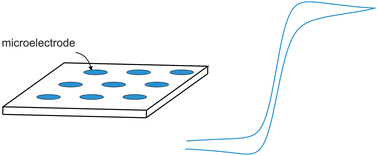Why ‘the bigger the better’ is not always the case when utilising microelectrode arrays: high density vs. low density arrays for the electroanalytical sensing of chromium(vi)
Abstract
We demonstrate, with the example of the electroanalytical sensing of chromium(VI) using ultra-microelectrode arrays, that a larger number of microelectrodes comprising an array do not necessarily provide improved electroanalytical performance. Using a low density array, which consists of 256 microdiscs where each microdisc comprising the array has a radius of 10 microns in a cubic arrangement separated from their nearest neighbour by 100 microns, the electroanalytical sensing of chromium(VI) is shown to be possible over the range 13–428 µM with a limit of detection of 3.4 µM readily achievable. Using a high density microelectrode, consisting of 2597 microdiscs where each microdisc has a radius of 2.5 microns in a hexagonal pattern which are separated from their nearest neighbour by 55 microns, the electroanalytical performance, in terms of linear range and sensitivity, is considerably lower going against the misconception that a high density array should produce a superior analytical response. The reason for this disparity is discussed and it is shown that the arrangement of the microelectrodes on the array is critical due to the interaction of diffusion zones between neighbouring electrodes allowing analysts to make informed decisions on the conscientious choice of microelectrode arrays.


 Please wait while we load your content...
Please wait while we load your content...